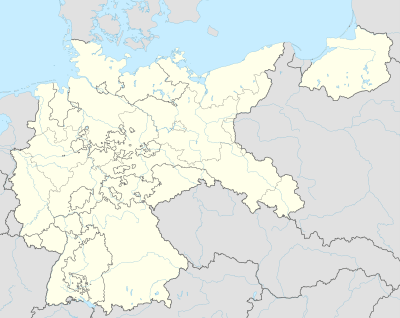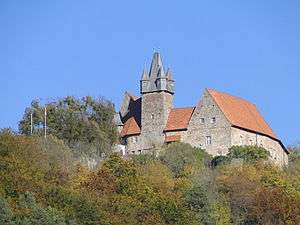Oflag IX-A/H
| Oflag IX-A | |
|---|---|
| Spangenberg, Hesse | |
|
Schloss Spangenberg | |
 Oflag IX-A | |
| Coordinates | 51°7′9.86″N 9°39′43.51″E / 51.1194056°N 9.6620861°E |
| Type | Prisoner-of-war camp |
| Site information | |
| Controlled by |
|
| Site history | |
| In use | 1939–1945 |
| Garrison information | |
| Occupants | French and British officers |
Oflag IX-A was a World War II German prisoner-of-war camp located in Schloss Spangenberg ("Spangenberg Castle") in the small town of Spangenberg in northeastern Hesse, Germany.
Camp history
The camp was opened in October 1939 as Oflag IX-A[1] to house POWs from the British Royal Air Force and the French Armée de l'Air.[2] The camp was renamed Oflag IX-A/H (Hauptlager, "Main camp") in June 1940,[1] after Oflag IX-C at Rotenburg an der Fulda became a sub-camp (Zweiglager) designated Oflag IX-A/Z.[3]
The first person to escape from the camp was Flight Lieutenant Howard Wardle in August 1940, but he was recaptured and sent to Oflag IV-C at Colditz Castle.[4]
The camp was closed in February 1941, but reopened in July when it was used for housing RAF and British Army officers.[2] On 3 September 1941 three RAF officers, Dominic Bruce, Peter Tunstall and Eustace Newborn, escaped disguised as members of a "Swiss Commission". They were escorted to the main gate by another prisoner, John Milner, dressed in a German officers uniform that had been found in an apparently forgotten set of attic rooms. They passed through the gate, and then, wearing faked Luftwaffe uniforms, headed to an airfield near Kassel intending to steal a Ju 52, which Newborn had flown before the war, and fly home. Unfortunately, there were no suitable aircraft, so they decided to head to France and contact an escape line. After ten days they arrived at Frankenberg, but were challenged by soldiers suspicious of their uniforms. Speaking little German they were soon identified as escapees and arrested. Returned to Spangenberg, the three were each sentenced to fifty-three days in solitary.[5]
As a result of this, and other escape attempts, the camp was evacuated in October 1941 with all prisoners being sent to Oflag VI-B.[2] The camp was reopened in January 1942, and housed British and Commonwealth army officers.The Germans marched the prisoners east on March 29. The Americans liberated the camps inmates at Lengefeld unterm Stein on 4 April.[6] Spangenberg Castle was destroyed by American bombs after Oflag IX A/H had left.[2]
Notable prisoners
The following prisoners are known to have been held at the camp:;[7]
- Pilot Officer Anthony Barber, No. 1 Photographic Reconnaissance Unit RAF. Future Chancellor of the Exchequer.
- Flight Lieutenant Dominic Bruce, No. 9 Squadron RAF. Colditz escaper.
- Flight Lieutenant Aidan Crawley, RAF. Future author, journalist and MP.
- Wing Commander Harry Day, No. 57 Squadron RAF. Great Escape survivor.
- Major General Victor Fortune G.O.C 51st (Highland) Division. Captured at St Valery in June 1940. Senior British officer P.O.W in Germany. Despite declining health, refused to be repatriated. Knighted after his release for his work to promote welfare of British P.O.Ws. Building of cricket pitch at Spangenberg organised under his direction.
- Lieutenant Colonel John Frost, 2nd Battalion, Parachute Regiment. Captured in the Battle of Arnhem.
- Captain Guy Griffiths, 803 Naval Air Squadron. Stalag Luft III forger.
- Wing Commander Joseph Kayll, No. 607 Squadron RAF. Battle of Britain ace.
- Lieutenant George Lane, X Troop, No. 10 (Inter-Allied) Commando. Captured during Operation Tarbrush.
- Lieutenant Airey Neave, Royal Artillery. Colditz escaper and MP.
- Pilot officer Eustace Charles Newborn. Captured Gazala, escapee and future medical obestetrician.
- Squadron Leader Brian Paddon, No. 40 Squadron RAF. Colditz escaper.
- Flying Officer Oliver Philpot, No. 42 Squadron RAF. "Wooden Horse" escaper.
- Major Bruce Shand, 7th Armoured Division. Captured in the Western Desert Campaign. Father of Camilla, Duchess of Cornwall, second wife of Charles Windsor, Prince of Wales.
- Major Dickie Stewart, Border Regiment, 1st Airlanding Brigade. Captured in the Battle of Arnhem.
- William Francis Kynaston Thompson OBE, captured on 20 September 1944 during Market Garden
- Wing Commander Robert Stanford Tuck, No. 257 Squadron RAF. Battle of Britain ace.
- Squadron Leader Pete Tunstall, No. 61 Squadron RAF. Serial escaper and Colditz POW.
- Pilot Officer Howard Wardle, No. 218 Squadron RAF. Colditz escaper.
- Bill "Tiger" Watson, 2 Commando. Participant in Operation Chariot, the raid on the Saint-Nazaire drydock.
- Micky Burn, 2 Commando. Participant in Operation Chariot, for which he was awarded the Military Cross. Later transferred to Colditz.
- Donald "The Laird" Roy, 2 Commando. Participant in Operation Chariot, for which he was awarded the Distinguished Service Order (DSO). Escaped but captured and returned after 10 days.
See also
References
- Notes
- 1 2 Mattiello (1986), p.206
- 1 2 3 4 WO208/3293 The National Archives Official Camp History O9A/H & O9A/Z
- ↑ Mattiello (1986), p.207
- ↑ Reid (1952), p.65
- ↑ "Crash No 107 Wellington T2620 09-06-1941" (PDF). Wings to Victory Museum. 2012. Retrieved 21 April 2012.
- ↑ http://www.thehistorypress.co.uk/index.php/the-march-east-1945-ebook.html
- ↑ Rollings (2003), Appendix II
- Bibliography
- Mattiello, G.; Vogt, Wolfgang (1986). Deutsche Kriegsgefangenen-und Internierten einrichtungen 1939–1945 [German prisoners of war and internee facilities 1939-1945] (in German). Koblenz: Selbstverlag.
- Reid, P.R. (1952). The Colditz Story. Hodder & Stoughton.
- Rollings, Charles (2003). Wire and Walls : RAF prisoners of war in Itzehoe, Spangenberg and Thorn 1939-42. Hersham, Surrey: Ian Allan Publishing. ISBN 0-7110-2991-1.
- Mansel, John. "The Mansel Diaries" (1977). Privately printed. ISBN 0950391115
